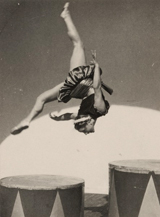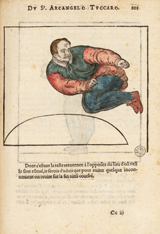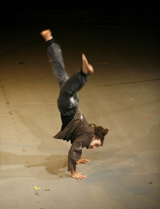by Denis Hauw
Ground-based acrobatic techniques correspond to actions that bring together muscular synergies, sensations, emotions and intentions in an original way; in other words, singular experiences combined with know-how. These techniques are expressions of interactions between man and his environment: here, the acrobat and the possibilities that ground-based acrobatics offers can be considered as minimalist, if we compare them for example to the possibilities that are available when using a trampoline thanks to the elasticity of the web, or in freestyle skiing, with the snow ramps that make rotation easier. The "ground" therefore offers relatively limited acrobatic possibilities (even if the materials used are becoming more and more elastic) and the acrobats must exploit a multitude of their qualities to generate the acrobatic feats.
The characteristics of the circumstances where an acrobatic / ground interaction occurs can be summarised by:
a) a somewhat reduced flight height compared to other acrobatic circumstances;
b) an obligation to use two fundamental biomechanical principles to initiate aerial rotations: the transfer of kinetic momentum and offsetting of the centre of gravity’s force;
c) limited perception, constrained by low ground-contact time / flight time differentials compared to other acrobatic practices;
d) an organisation of the global activity leaving little margin for the sequencing of successive units of actions, given the limited available air time.
Looked at from this perspective, the technical foundations of ground-based acrobatics aim to maximise this interaction to allow for the realisation of complex, elaborate or creative acrobatic figures. They are also useful for other types of acrobatic circumstances if we accept that they constitute a sort of propaedeutic to acrobatic activity in general. Thus, the "technical foundations" must be considered as all the actions that produce acrobatic activity on the ground. They provide the keys to making the acrobat / circumstances interaction viable, allowing one to learn complex acrobatic figures in complete safety and in accordance with the execution standards that preside over their realisation.
The technical foundations of ground-based acrobatics can be divided into three themes of interaction, each presenting their own characteristics: free rotations, inversions and inverted balances.
Free rotations
This field relates to the possibility of performing so-called "fundamental" acrobatics, such as the front or back flip. The basic techniques are focused on the initiation of aerial rotation and its control.
To initiate the rotation, two basic techniques are recommended.
The first one focuses on the use of off-centred propulsion from the lower limbs, obtained by adding a slight forward bending of the bust for forward rotations or the extension of the upper back for backward rotations. The second corresponds to the transfer of kinetic momentum obtained by blocking the speed of the run up during the forward momentum of the take off. In both cases, the techniques contain fundamental postural elements: controlling the body’s distortion at the moment of propulsion (controlling the body’s angle according to the circumstances), positioning the arms along the vertical axis at take-off, keeping one’s head and line of sight straight.
To steer the rotation, the basic technique is combines a sort of “puck” body position (i.e. the contraction of the terms "pike" and "tuck") while leaving the arms free on each side of the body.
The basic technique of control consists of the possibility of adopting and leaving this "puck" position at the right moment: one has to know how to adjust it to the speed of rotation and the height of flight acquired. This adjustment also includes the dissociation of these different actions.
The sensation of taking off, spinning and landing must be perceived by the acrobat and be confirmed by the judgment of an outside observer who should be able to identify the start of the rotation at take-off, its acceleration when the acrobat sets his position, and finally its slowing down and stopping at the landing.
Mastery of these basic techniques makes it possible to construct double rotations, combined rotations (back flip twist), sequences of free rotations (double back flip), or even more original rotations, such as a side somersault.
Inverted balancing
This field is defined by the possibility of making taught inverted contact with the ground in different circumstances. Basic techniques focus on positioning and holding the correct position.
There are three basic, separately identifiable means of arriving at an inverted position:
a) the dynamic extension of one free leg associated with the thrust of the other, from a “forward lunge” position;
(b) the "back placement" or the unrolling of the spine from a squatting position with the hands on the floor;
c) the simultaneous propulsion of the two lower limbs in a forward direction (like when diving).
These techniques of getting into a balancing position define muscular synergies, mobilising different possible degrees of freedom for the acrobatic actions. Thus, the "forward lunge" starting position implies a dissociation of the actions of the two lower limbs; the "back placement" positioning requires the mastery of progressively unrolling the spine with a delayed placement of the lower limbs; and that of the "simultaneous impulse of both lower limbs" implies a dynamic back-extension synergy and an anticipated alignment of the lower limbs with the body.
The technique of holding the position relates to the possibility of voluntarily controlling the inverted position, remaining stable for a time, with a precise sensation of one’s body: the weight-bearing hands aligned under the shoulders, which themselves are aligned with the externally rotated shoulder blades, and the feet, identified as a fixation point, like a pendulum. In other words, it is a question of being able to perceive one’s feet above one’s body with the latter in alignment thanks to a scapular alignment1, a blocking of the pelvis in retroversion and a mobilisation of the wrists to maintain balance.
The acquisition of these technical foundations circumscribes a mastery of inverted balancing that allows one to proceed to more complex actions on the ground, such as pirouettes or one arm handstands, as well as balances found in other acrobatic contexts like, for example, the big turns on bars or certain types of static pyramid in acrobatic gymnastics.
Inversions
This field is defined by the possibility of making rotations by placing the hands on the ground, such as the back flip2 or the handspring. The technical foundations consist of two basic actions:
a) the extension / locking of the lower limbs of the body which generates an off-centred momentum of the lower limbs, thus achieving and accelerating forward rotations in figures such as the handspring or front flip;
b) the closure / blocking of the body (which is the reverse action), also known as the "courbette3", consisting of a partial, dynamic closing of the lower limbs towards the torso. We also find this action in the round off, which can be related to this theme.
The mastery of these technical foundations is also reflected by a dissociation of the preparatory actions from those of the extension and/or closure of the bust. For example, one can identify the preparatory tensioning of the body, such as a slight closing of the pelvis before the extension, or an extension of the body before the courbette. The acrobat must feel, on one hand, the muscular tension generated in the glutei and back and the sensation of rotating and straightening combined for the extension technique and, on the other hand, the sensation of the straightening and backward rotation of the bust together with a forward thrust of the lower limbs for the closure technique.
These technical foundations offer perspectives for learning sequences of inversions such as the handspring, the front flip, the round off and the back handspring. They make it possible to acquire speed and to perform more complex free rotations.
In conclusion, the technical foundations of ground-based acrobatics are indicators of a certain capacity to make the acrobat's own qualities interact with the specificity of the circumstances. They guarantee the active safety of the practitioners by defining the contents that will enable one to achieve the founding principles of the different worlds specific to the acrobats.
1. Aligning the shoulders.
2. Flic-flac or flip-flap (back handspring), back of front flip.
3. Illustration of the coubette, diagram...










